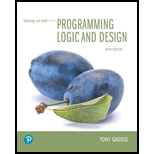
Starting Out with Programming Logic and Design (5th Edition) (What's New in Computer Science)
5th Edition
ISBN: 9780134801155
Author: Tony Gaddis
Publisher: PEARSON
expand_more
expand_more
format_list_bulleted
Textbook Question
Chapter 8, Problem 8AW
Design an
Expert Solution & Answer
Want to see the full answer?
Check out a sample textbook solution
Students have asked these similar questions
4. |z + 5 - 5i| = 7
14.
dz,
C: |z❘
C: |z❘ = 0.6
ze² - 2iz
H
14.
dz,
C: |z❘
C: |z❘ = 0.6
ze² - 2iz
H
Chapter 8 Solutions
Starting Out with Programming Logic and Design (5th Edition) (What's New in Computer Science)
Ch. 8.1 - Prob. 8.1CPCh. 8.1 - Prob. 8.2CPCh. 8.1 - Prob. 8.3CPCh. 8.1 - Prob. 8.4CPCh. 8.1 - Prob. 8.5CPCh. 8.1 - Prob. 8.6CPCh. 8.1 - Prob. 8.7CPCh. 8.1 - What does array bounds checking mean?Ch. 8.1 - Prob. 8.9CPCh. 8.2 - Prob. 8.10CP
Ch. 8.2 - Prob. 8.11CPCh. 8.2 - What does the loop do in the sequential search...Ch. 8.2 - Prob. 8.13CPCh. 8.2 - How do you look for a partial string match when...Ch. 8.3 - Prob. 8.15CPCh. 8.3 - Prob. 8.16CPCh. 8.3 - Describe the algorithm for finding the highest...Ch. 8.3 - Prob. 8.18CPCh. 8.3 - Prob. 8.19CPCh. 8.4 - Prob. 8.20CPCh. 8.4 - Prob. 8.21CPCh. 8.5 - Prob. 8.22CPCh. 8.5 - Write a pseudocode statement that assigns the...Ch. 8.5 - Prob. 8.24CPCh. 8.5 - Prob. 8.25CPCh. 8.6 - Prob. 8.26CPCh. 8 - Prob. 1MCCh. 8 - Prob. 2MCCh. 8 - This is an individual storage location in an...Ch. 8 - Prob. 4MCCh. 8 - Prob. 5MCCh. 8 - Prob. 6MCCh. 8 - Prob. 7MCCh. 8 - Prob. 8MCCh. 8 - Prob. 9MCCh. 8 - Prob. 10MCCh. 8 - Prob. 1TFCh. 8 - Prob. 2TFCh. 8 - Prob. 3TFCh. 8 - Prob. 4TFCh. 8 - Prob. 5TFCh. 8 - Prob. 1SACh. 8 - Prob. 2SACh. 8 - Look at the following pseudocode: Constant Integer...Ch. 8 - Prob. 4SACh. 8 - Prob. 5SACh. 8 - Prob. 1AWCh. 8 - Prob. 2AWCh. 8 - Prob. 3AWCh. 8 - Prob. 4AWCh. 8 - Prob. 5AWCh. 8 - Prob. 6AWCh. 8 - Assume the following declarations appear in a...Ch. 8 - Design an algorithm for a function that accepts an...Ch. 8 - Write a pseudocode algorithm that uses the For...Ch. 8 - Total Sales Design a program that asks the user to...Ch. 8 - Lottery Number Generator Design a program that...Ch. 8 - Prob. 3PECh. 8 - Prob. 4PECh. 8 - Charge Account Validation Design a program that...Ch. 8 - Days of Each Month Design a program that displays...Ch. 8 - Phone Number Lookup Design a program that has two...Ch. 8 - Payroll Design a program that uses the following...Ch. 8 - Drives License Exam The local drivers license...Ch. 8 - Saddle Points Design a program that has a...Ch. 8 - Tic-Tac-Toe Game Design a program that allows two...Ch. 8 - Lo Shu Magic Square The Lo Shu Magic Square is a...
Additional Engineering Textbook Solutions
Find more solutions based on key concepts
Give an example of a data constraint.
Database Concepts (8th Edition)
State whether each of the following is true or false. If false, explain why. All expression containing the | | ...
Java How to Program, Early Objects (11th Edition) (Deitel: How to Program)
Find the no-load value of υo in the circuit shown.
Find υo when RL is 150 Ω.
How much power is dissipated in th...
Electric Circuits. (11th Edition)
Explain what can be done with primary keys to eliminate key ripple effects as a database evolves.
Modern Database Management
Determine the magnitude of F2 which will cause the reaction C, at the bearing C to be equal to zero. The bearin...
INTERNATIONAL EDITION---Engineering Mechanics: Statics, 14th edition (SI unit)
What advantages does a vector offer over an array?
Starting Out with C++ from Control Structures to Objects (9th Edition)
Knowledge Booster
Learn more about
Need a deep-dive on the concept behind this application? Look no further. Learn more about this topic, computer-science and related others by exploring similar questions and additional content below.Similar questions
arrow_back_ios
SEE MORE QUESTIONS
arrow_forward_ios
Recommended textbooks for you
 C++ for Engineers and ScientistsComputer ScienceISBN:9781133187844Author:Bronson, Gary J.Publisher:Course Technology Ptr
C++ for Engineers and ScientistsComputer ScienceISBN:9781133187844Author:Bronson, Gary J.Publisher:Course Technology Ptr C++ Programming: From Problem Analysis to Program...Computer ScienceISBN:9781337102087Author:D. S. MalikPublisher:Cengage LearningProgramming Logic & Design ComprehensiveComputer ScienceISBN:9781337669405Author:FARRELLPublisher:Cengage
C++ Programming: From Problem Analysis to Program...Computer ScienceISBN:9781337102087Author:D. S. MalikPublisher:Cengage LearningProgramming Logic & Design ComprehensiveComputer ScienceISBN:9781337669405Author:FARRELLPublisher:Cengage EBK JAVA PROGRAMMINGComputer ScienceISBN:9781337671385Author:FARRELLPublisher:CENGAGE LEARNING - CONSIGNMENT
EBK JAVA PROGRAMMINGComputer ScienceISBN:9781337671385Author:FARRELLPublisher:CENGAGE LEARNING - CONSIGNMENT Programming with Microsoft Visual Basic 2017Computer ScienceISBN:9781337102124Author:Diane ZakPublisher:Cengage Learning
Programming with Microsoft Visual Basic 2017Computer ScienceISBN:9781337102124Author:Diane ZakPublisher:Cengage Learning Microsoft Visual C#Computer ScienceISBN:9781337102100Author:Joyce, Farrell.Publisher:Cengage Learning,
Microsoft Visual C#Computer ScienceISBN:9781337102100Author:Joyce, Farrell.Publisher:Cengage Learning,

C++ for Engineers and Scientists
Computer Science
ISBN:9781133187844
Author:Bronson, Gary J.
Publisher:Course Technology Ptr

C++ Programming: From Problem Analysis to Program...
Computer Science
ISBN:9781337102087
Author:D. S. Malik
Publisher:Cengage Learning

Programming Logic & Design Comprehensive
Computer Science
ISBN:9781337669405
Author:FARRELL
Publisher:Cengage

EBK JAVA PROGRAMMING
Computer Science
ISBN:9781337671385
Author:FARRELL
Publisher:CENGAGE LEARNING - CONSIGNMENT

Programming with Microsoft Visual Basic 2017
Computer Science
ISBN:9781337102124
Author:Diane Zak
Publisher:Cengage Learning

Microsoft Visual C#
Computer Science
ISBN:9781337102100
Author:Joyce, Farrell.
Publisher:Cengage Learning,
1.1 Arrays in Data Structure | Declaration, Initialization, Memory representation; Author: Jenny's lectures CS/IT NET&JRF;https://www.youtube.com/watch?v=AT14lCXuMKI;License: Standard YouTube License, CC-BY
Definition of Array; Author: Neso Academy;https://www.youtube.com/watch?v=55l-aZ7_F24;License: Standard Youtube License